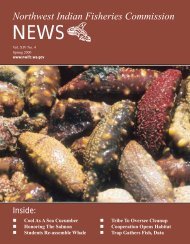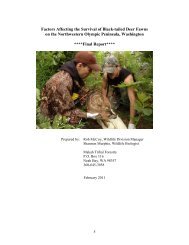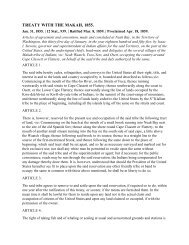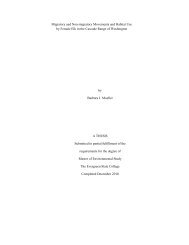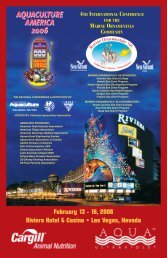Draft TRT Document â for Discussion Purposes ... - NWIFC Access
Draft TRT Document â for Discussion Purposes ... - NWIFC Access
Draft TRT Document â for Discussion Purposes ... - NWIFC Access
Create successful ePaper yourself
Turn your PDF publications into a flip-book with our unique Google optimized e-Paper software.
<strong>Draft</strong> <strong>TRT</strong> <strong>Document</strong> – <strong>for</strong> <strong>Discussion</strong> <strong>Purposes</strong> – OK to circulate2. sustainability under historical conditions, and3. demographic independence.For the majority of presumptive DIPs there was insufficient in<strong>for</strong>mation todirectly address the sustainability and demographic independence criteria. To address thesustainability issue one would need a historical assessment of productivity andabundance. Historical sources can provide some quantitative measures of abundance,primarily harvest estimates (commercial, tribal, and sports fisheries) and hatchery weircounts, but more frequently historical documents provided qualitative measures,generally reporting the presence of significant spawning aggregations in reports orsurveys. In the absence of in<strong>for</strong>mation on harvest intensity or hatchery collectionprotocols, any expansion of this in<strong>for</strong>mation to estimate total run size cannot be donewith great precision. Anecdotal accounts were useful in establishing historical presence,but it was more challenging to quantify abundance from notations such as “They werethick as crickets” (Stone, 1895). For the purpose of identifying DIPs it is only necessaryto establish a minimum threshold <strong>for</strong> sustainability, whereas estimating historical run sizeis more useful in population viability modeling.The <strong>TRT</strong> discussed at length what a minimum size metric <strong>for</strong> a sustainablesteelhead population would be. The <strong>TRT</strong> concluded, based in part on recommendationsin Allendorf et al. (1997), that an effective population size (N e ) of 500 per generation wasan appropriate minimum size <strong>for</strong> a DIP. The relationship between effective populationsize and census size (N) also was discussed at length. Waples et al. (1993) suggested that<strong>for</strong> interior Columbia Basin Chinook salmon populations this ratio is on the order of 0.20to 0.25. Ford et al. (2004) found similar results <strong>for</strong> Oregon coastal coho salmon.Steelhead express life history characteristics that are in many ways substantially differentfrom those of Pacific salmon. Overall, the net effect of these differences would result inan increase in the ratio between N e and N. It is likely that the presence of resident O.mykiss that produce anadromous adult offspring, either by interbreeding directly withtheir anadromous counterparts or independently, contributes significantly to abundancedynamics of the anadromous population. The contribution may be especially importantwhen ocean conditions are poor and the survival of the anadromous component is low.The fact that steelhead are iteroparous further increases the number of effective parents ina population and may reduce between year variability. Assuming Puget Sound steelheadhave an average generation time of 4 years, a minimum effective steelhead populationsize of 500 anadromous fish per generation translates to an effective number of breeders(N b) of 125 fish per year. If the N e /N ratio <strong>for</strong> steelhead is higher than that <strong>for</strong>semelparous Pacific salmon, perhaps twice the level (0.50), then the minimum annualescapement <strong>for</strong> a population would need to be 250 fish. In other words, with 250anadromous spawners in a year, one could expect 125 effective breeders that year. Therewas some disagreement voiced by a number of <strong>TRT</strong> members about the estimate of 250fish per year being the minimum escapement needed to meet effective size threshold.Alternative escapement estimates were roughly balanced at levels below and above the250 fish estimate. Varying escapement estimates were utilized in combination withhabitat-based models of productivity to establish a relative run size minimum <strong>for</strong> asustainable population.14



